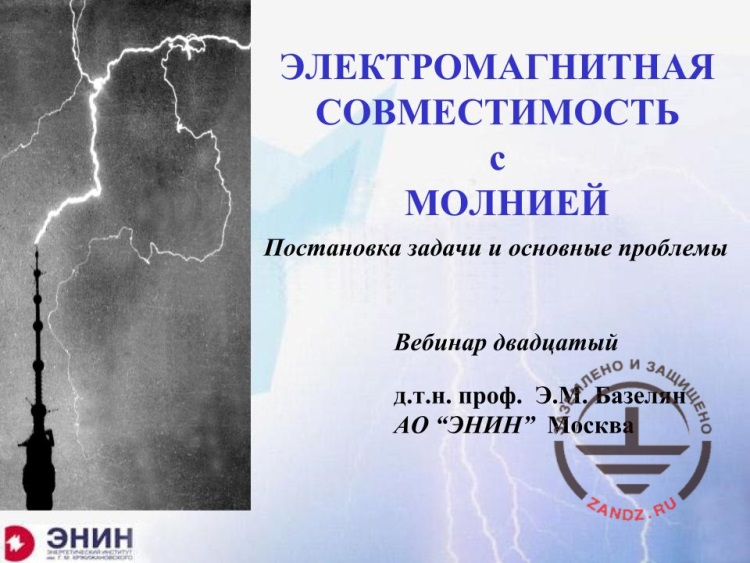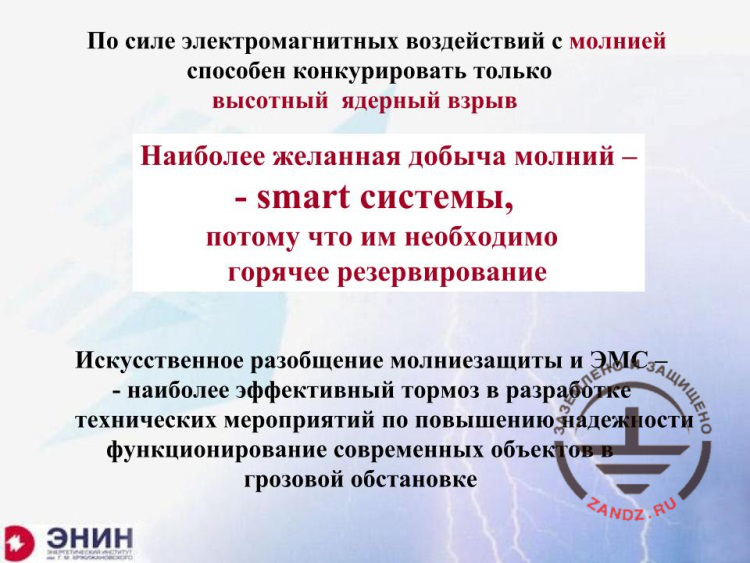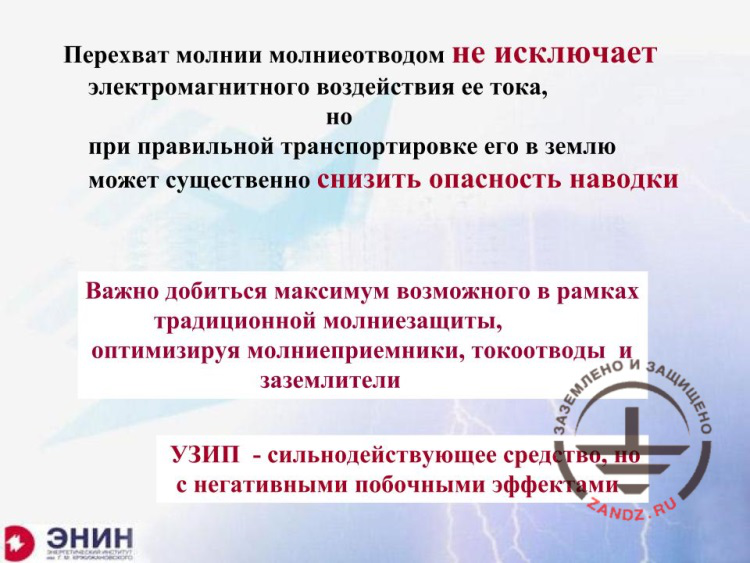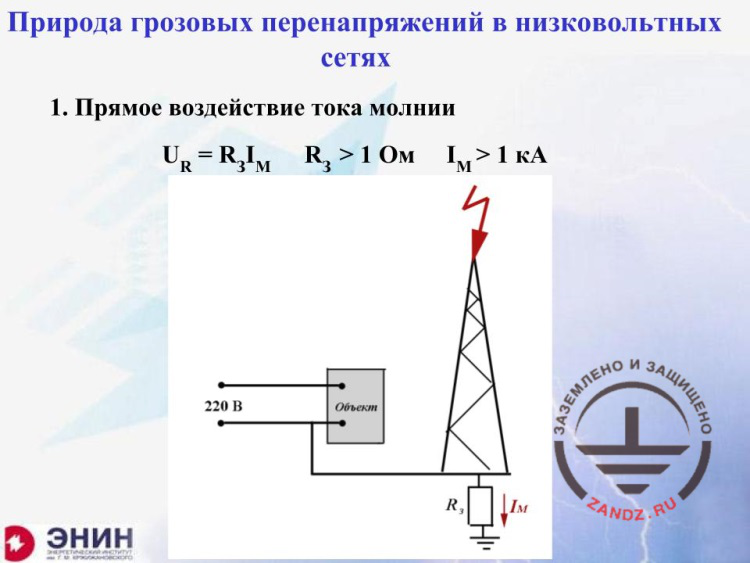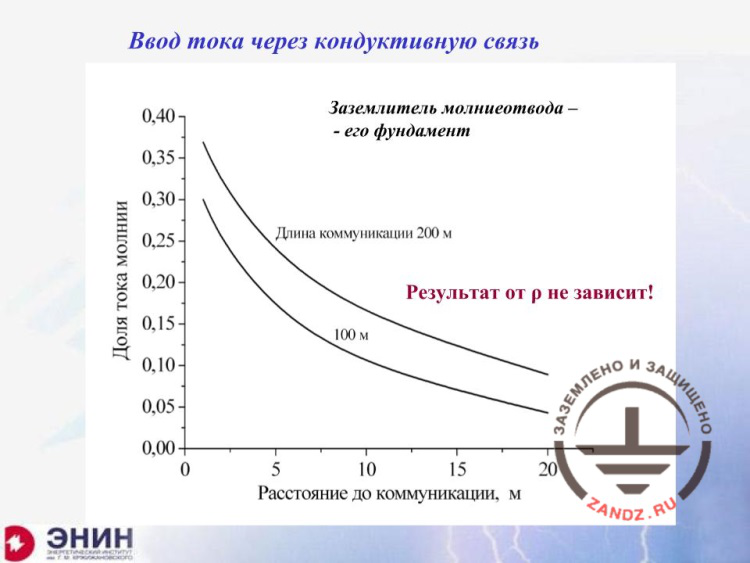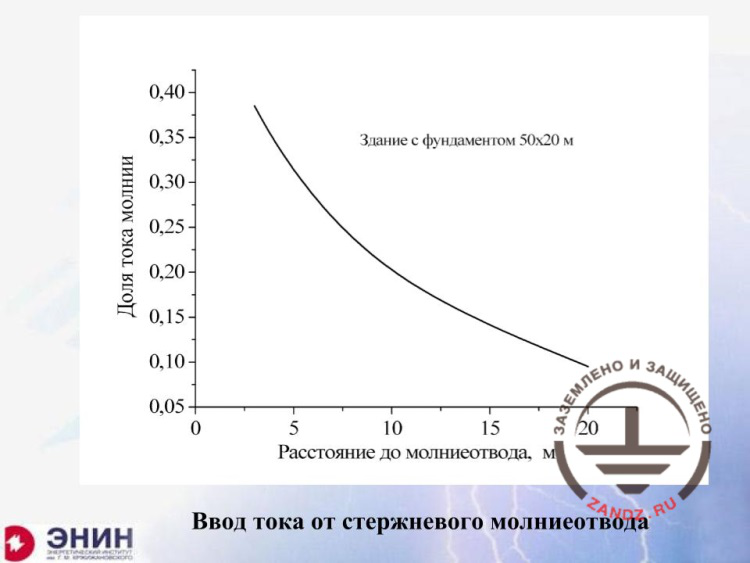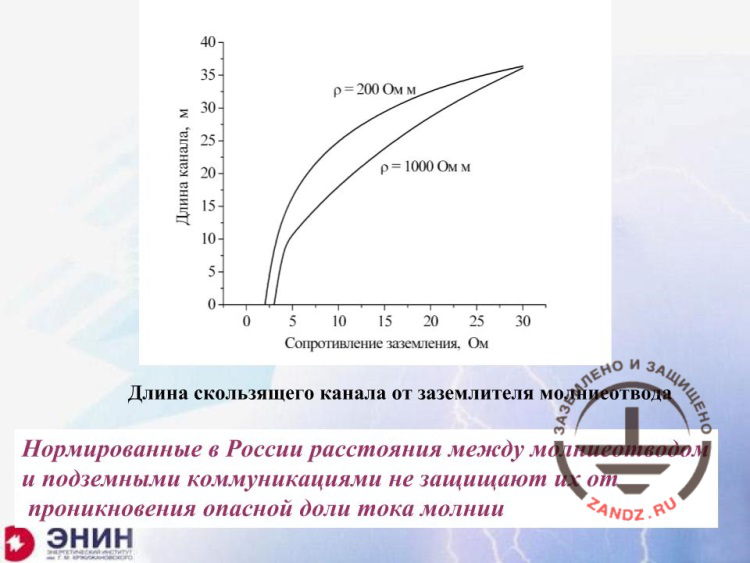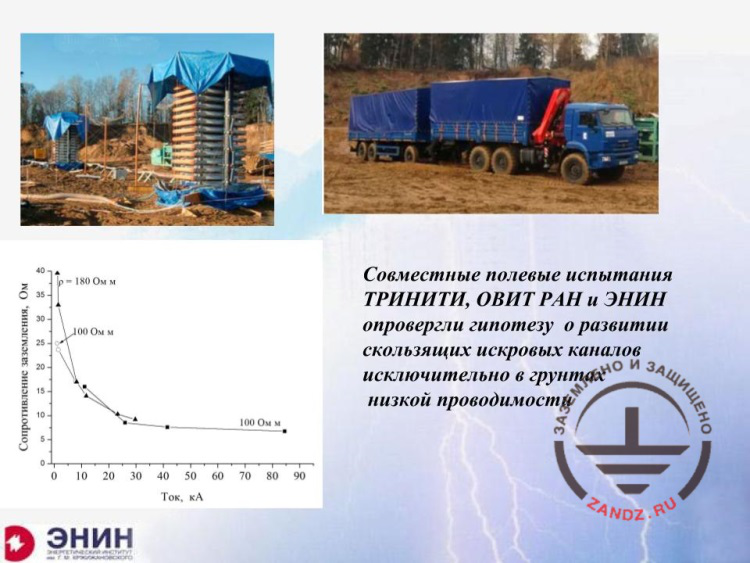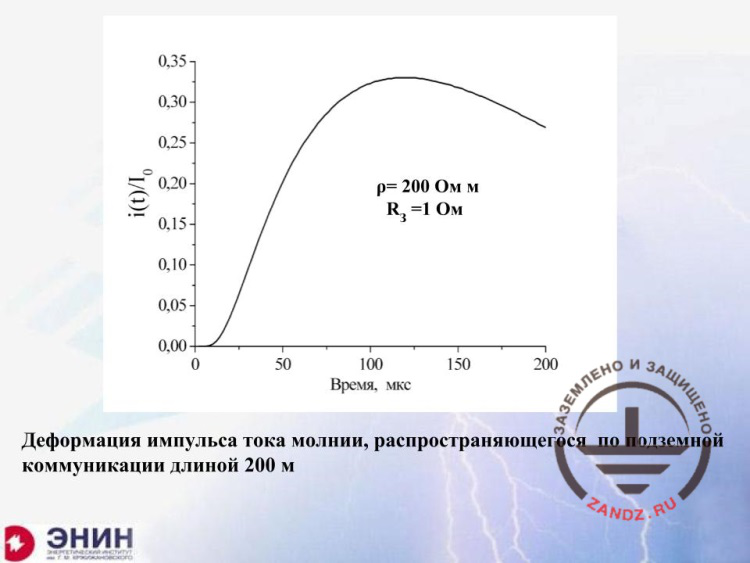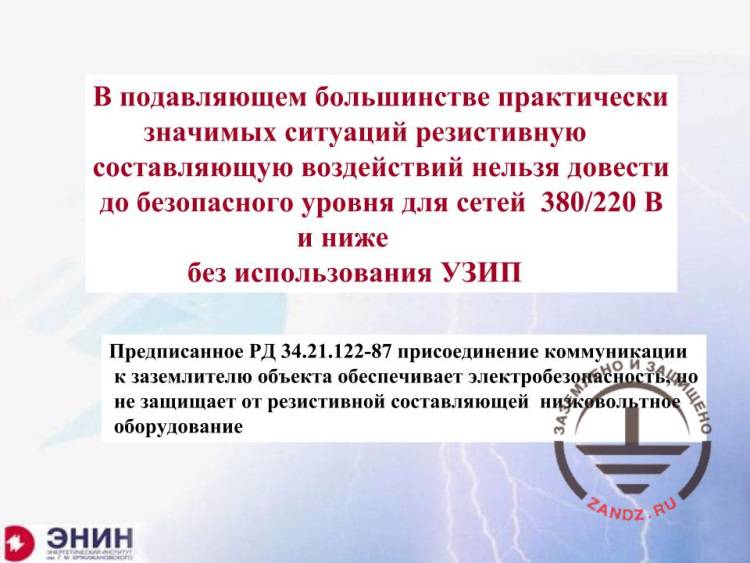|
The twentieth webinar of "Earthing and Lightning Protection: Design Issues and Problems" series The webinar is intended for: designers of lightning protection and earthing |
|
|
From the author: A year ago, ZANDZ experts asked me to continue the series of books dedicated to lightning and lightning protection. The offer was well-timed because of the total trend for using smart systems in various technical applications. Their common feature is a single control unit that collects data from multiple sensors and compares it with the previous data to automatically generate the next control input. The control unit must be reliably protected from electromagnetic effects. Redundancy is not of any help in this case because it must be hot. Otherwise, the history of control inputs will not be available for it. In such situation, when the electromagnetic field of the lightning damages the main unit, it also breaks down the redundant devices. You cannot avoid the protection here. |
720p full screen watching is recommended. |
Webinar text. Page 1 |
|
Approximate reading time: 48 minutes.
– Good afternoon, dear colleagues! Let's begin. As usual, let me say some words about organizational aspects. Today, we start a series of webinars titled "Electromagnetic Сompatibility with Lightning". The speaker is an acknowledger expert in lightning protection and earthing, professor Eduard Meerovich Bazelyan. Good afternoon, Eduard Meerovich! Let me proceed, while Eduard Meerovich is connecting. Our current webinar is dedicated to: "Electromagnetic Compatibility with Lghtning. Statement of the Problem and Major Issues". The next webinar of this series will be held on August 8 and will be dedicated to the following subject: "What do we need to calculate to solve the issue of electromagnetic compatibility with the lightning current?" We will send the link for registration. If you have not registered yet, do it now. Do not miss our events. Let's remember that this webinar will be held on August 8. The link is provided in the chat. I also remind you that a series of webinars for the BIM design is being held. The next webinar of this series will be on July 18. You can also use the link in the chat to get the details and register for this webinar. I will send it to you. You may get the information on new events on the website as well as in the social media groups. I will also send the links into the chat. Join the social media groups or register on the website. Do not miss the relevant events. Well, some words about the organizational aspects: our current webinar will take 60 to 80 minutes depending on your activity and questions. We will answer your questions at the end of the webinar. I ask you to write your questions in the "Questions" tab specifying the speaker's phrase or slides it refers to. Let me note one more point. We will answer the questions that are related to the webinar subject. All the remaining questions will also be answered later in writing. I ask you to write the questions for the current webinar, which are related to the webinar subject only. So, I ask you to be active, leave your questions and leave comments in the chat. Now, the introductory word is over, and I give the turn to the speaker. Good afternoon, Eduard Meerovich!
— Good afternoon, dear colleagues! You know, it is surprising for me that, during the football championship, we have gathered about 100 people who want to study the electromagnetic compatibility. It is very pleasant for me. Before proceeding to the actual seminar content, I want to note the reason why it has been developed. Our laboratory has received an order for the development of an industrial standard for using SDPs. And we had to study the existing documents to understand what document we had to develop. And I began to read them and I had a bad feeling because the guidelines in those documents could provide a calculation error of about 100%. Then, during the conference held in Saint Petersburg this year, we have decided that we would present a report on electromagnetic compatibility with the lightning. And I started to prepare this report. But in order to avoid trivialities, I read the available scientific literature devoted to electromagnetic compatibility. I cannot think of myself as a good theorist, but I still have got some theoretical works. However, I could not even read a half of these monographs devoted to electromagnetic compatibility. I did not have a tenacity to finish them. And then I understood that I had to write a book describing electromagnetic compatibility. First of all, because physics, although this may be surprising, is a science that is described in words, and the formulas in physics are required to determine values. So, I wanted to write a small book on electromagnetic compatibility. I understood that the book should be small, and the reason is given below. What is the lightning electromagnetic effect on facilities? Its physics is very simple. The lightning current flows along the resistance and creates the voltage drop therein. This is the first point. The second point is that there is an electromagnetic induction and there is an electrostatic induction that also creates a surge. Generally, the physical basis for this event is very simple. I could not understand why it is described so awful. The second point I understood was the following: the electromagnetic compatibility applies to the low-voltage equipment, and you need to handle the low-voltage equipment with care. This is because, for example, although the electromagnetic effect lasting for nanoseconds does not present any danger for the high-voltage equipment, it is still fatal for the electronic units. And these points should be necessarily considered. And I understood that they should be included into the book. And when I started my work on the book, we have thought of this series of webinars, the first of which is being carried out today. I would like to note one more point that is very important: do we need this subject today? The relevance of the electromagnetic compatibility issues is associated with the word "smart". Smartphone. When I turn on TV, the "smart" message appears on the screen. Smart cars ride in the streets and have already managed to kill a woman in a road traffic accident. It means that today, everybody tend to provide complete automation. And such complete automation means only one aspect: any "smart" system contains a single control unit. Such single control unit collects the inputs from numerous sensors, compares the received data with the previous one and generates the next input. It is clear that such system should be very reliable. And we want to provide the reliability of such system using the simple thing, by making hot redundancy, i.e. adding one more unit. But the point is that this redundancy should be hot. It must work in parallel to the main equipment. Because, if it does not work in parallel, it will not be able to access the history. And if it does not know the history, how can it generate the correct input? And the redundant unit must be turned on together with the main unit; however, in this case, the electromagnetic effect of the lightning will break down both the main and the redundant units. And high protection reliability is absolutely required here. This is the reason why we have to do all the main things.
– Now, what is the most important aspect? We have got the lightning protection and the lightning arrester. It catches the lightning discharges. By catching the lightning discharge, the lightning arrestor does not exclude the electromagnetic effect of the current. It is because the lightning current, when it flows along the lightning arrester, creates the same magnetic field as in the case when it flows along the lightning channel. And therefore, the installation of the lightning arrester does not solve the electromagnetic compatibility issues. It does not solve them, but by installing the lightning arresters, you can either alleviate the electromagnetic compatibility issue or, on the contrary, worsen the situation extremely. Because, for example, if the lightning arrester is very high, then it will collect very many lightning discharges. And a very adverse electromagnetic environment will be created around the lightning arrester. The second point is that if I let the lightning current go into the earth correctly, I can drastically change the electromagnetic environment in a room. As a result, I can rather dramatically reduce the electromagnetic interference. When I know these provisions and can use them, I can provide a favorable situation in the environment within your facility, and (which is a critical point) try avoid using SDPs. If you access Internet and read the advertising, you will see that many SDP manufacturers state something like this: "Why do you mess about it? Buy our SDPs, install them into all circuits you have got and they will protect your equipment". And this is true, they will protect all equipment, indeed. I have seen with my own eyes the cabinets filled with many hundreds or even several thousands of SDPs, each of them having a price of several hundred dollars. All of them were installed to protect equipment. They protect it well, even though they are expensive, but the point is that the SDP is a rather complex device. SDPs may break down, they may degrade or just damage. And your electrical circuit is full of hundreds of such unreliable devices. And then the operating reliability of your circuit is dependent on the reliability of SDPs you have installed. And the reliability may decrease significantly. Not without a reason, the leading European companies today offer the device that automatically controls the SDP condition and sends such information to the control board. I want you to avoid these problems. The point is as follows.
– Now, let's talk about the surge nature. It is very simple. You have got a lightning that strikes the lightning arrester. The lightning current flows along the lightning arrester's pole and gets into the earth through its resistance. As a result of this, a potential appears in the earthing bus point according to the Ohm's law. And what happens then? The next thing happens. What earthing resistance you may have? Imagine that you have got a very good resistance. Assume that it is 1 Ohm. Then the 1 kA current creates the voltage drop of 1 kV, and the 2.5 kA current creates the voltage of 2.5 kV, and 2.5 kV is the electrical strength of the insulation in a conventional design for 220 V circuit. It means that the lightning with any current, and the average lightning current is 30 kA, will break down your circuit if it is not provided with protection or you do not decrease this voltage in some way. I understand that I have said a trivial phrase as everybody understand it.
– But there is a more important point. Here it is. If such small currents may break down low-voltage equipment, and the electromagnetic compatibility issue is unresolved, you do not need to wait for the direct lightning strike into the facility. Rather low lightning currents may flow to the facility in different ways. For example, you have got a lightning arrester, and at the distance of about ten meters, an underground cable line is located. There exists a conductive coupling between such lightning arrester and the cable line. And it exists anyway because it cannot be other way round, since the earth is a conductor. Look at what happens. If I have got, for example, an underground cable line that is one or two hundred meters long, then at the distance of ten meters from the lightning arrester, this line will collect 10 to 15% or even 20% of the lightning current. What does it mean? With the average current being equal to 30 kA, not less than 3 kA will get into the line, and it means that there will be an interference at the earthing device of the facility, and its value will exceed the electrical strength of insulation.
– It is understood that such line can also represent an earthing device of the building. It is because if you have got a building, then according to the Russian laws, its earthing circuit is defined by the reinforced concrete foundation. And now let's take another example: I have got a building with the area of 50 x 20 m. It is a typical administrative or residential building. And the lightning current is taken away from the earthing device of the lightning arrester into such foundation of the building depending on the distance. At the distance of 10 meters, about 20% of the lightning current get into the earthing device of the building. These 20% of the lightning current are equal to 6 kA, even if we assume the average lightning. These 6 kA will create a very significant voltage drop in the earthing devices of this building. First, I used the earthing resistance of 1 Ohm, but generally it is a fake. Why is it a fake?
– This is the reason why. The earthing resistance in the stationary mode may actually be low. But in the pulse mode, it rises dramatically because the lightning current needs time to distribute in the earth. And this time means fractions of a microsecond. The fractions, during which high resistance is not important for high-voltage equipment. You cannot damage high-voltage equipment when you expose it to the fractions of a microsecond. But they are enough to damage the insulation of 1 mm thick. For this reason, in real life, the danger of the low-voltage equipment exposure to the voltage passing through the earthing resistance is very high. There is one more issue that can be explained as follows. If you read the mentioned regulatory documents, you will see such text: to break through the insulation gap in the soil, you need 300 kV/m, and to break through this gap on the soil surface, you need about 100 kV/m. It is specified in the Russian regulatory documents. What do we have in real life? And the reality is as follows: the direct experiments, and I highlight that they are direct, show that to break through the distance of about 30 meters, you need only the voltage of 300 kV. It turns out that, in order to achieve the breakthrough, you do not need 100 kV/m, you only need 10 kV/m. Such creeping discharges along the soil surface in the conditions like I said, they have been recorded directly. To remove these discharges, you need very low earthing resistances of about 1 Ohm for the lightning arresters. The lightning arresters do not virtually have such earthing resistances, and they are never rated. Therefore, such spark channels along the soil surface are always observed, but we had a strong belief. The belief was of the type: "Such spark channels only develop in "bad" soils. They may be in rocks, in permafrost. But in good soils, for example, in the black earth, nothing like this happens."
– Two years ago, we, and I mean a large team consisting of several research institutes: Integrated Institute of High Temperatures of the RAS, TRINITI Center, and our ENIN. We have designed a system that is a source transported in the KAMAZ trucks. It could be assembled in any location and produced the currents of almost up to 100 kA with the lightning current parameters. And when it was done, we saw that, due to such currents, the earthing resistance is reduced 5–6-fold due to the formation of lengthy spark channels in highly conductive soils. We are talking about the soils with the resistivity of 100 and even 70 Ohm*m. These are black and bog soils. As the expression goes, it cannot be any lower. Therefore, the danger of spark channels exists almost anywhere and any time.
– I have to note one more point. When the lightning current goes to the underground utility and reaches the facility, then... if you read RD 34, you will see that: "To eliminate the risk of high potential getting into the underground utilities, you have to connect them to the facility earthing circuit". I have got a graph for the following thing here: a typical, average soil in Russia, the resistivity is 200 Ohm*m, and the earthing resistance of the facility is very good, it is 1 Ohm. Now look what comes along the utility of 200 meters long to this earthing device of the facility. It turns out that about 30–35% of the lightning current striking the earth or the lightning arrester reach the earthing device of the facility. If it is the average lightning current, then if we take 30 kA, it will be 10 kA. And 10 kA with the resistance of 1 Ohm is 10 kV. 10 kV are fatal for any 220–380 V equipment. But there are even more problems. I ask you to keep this fact in mind. Look at it, please. When I performed this calculation, I did it for the rated lightning current with the 10 mcs front, and the pulse reached the facility with the front duration increased from 10 mcs to 100 mcs. Under these conditions, SDPs begin operating awfully. They just cannot perform their functions. I will not explain this issue today. It is a subject for further seminars. But I ask you to pay attention to this fact.
– How can I conclude? I can conclude as follows: in most situations, the resistive component of the interference from the lightning current that flows along the earthing resistance is almost in all cases dangerous for low-voltage equipment. We cannot likely avoid using SDPs here. And the recommendations I referenced to, which are provided in RD 34, are as follows: if you make such earthing, your people will be safe and sound, you will have no electric injuries. But with regards to the electromagnetic interference, they will exist to the fullest extent. Unfortunately, this is not a very good conclusion.
Next page >>
|
Related Articles:


 Lightning Protection of Large Territories: Parks, Grounds, Plant Territories. Page 1
Lightning Protection of Large Territories: Parks, Grounds, Plant Territories. Page 1
 Lightning Protection of Large Territories: Parks, Grounds, Plant Territories. Page 2
Lightning Protection of Large Territories: Parks, Grounds, Plant Territories. Page 2
 Lightning Protection of Large Territories: Parks, Grounds, Plant Territories. Page 3
Lightning Protection of Large Territories: Parks, Grounds, Plant Territories. Page 3


